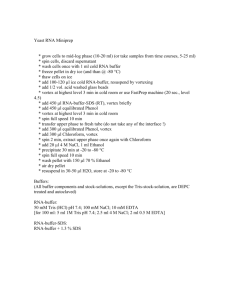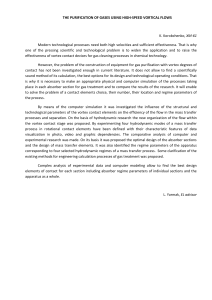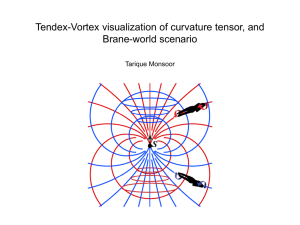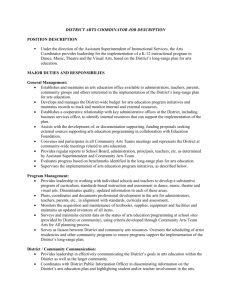Diapositiva 1
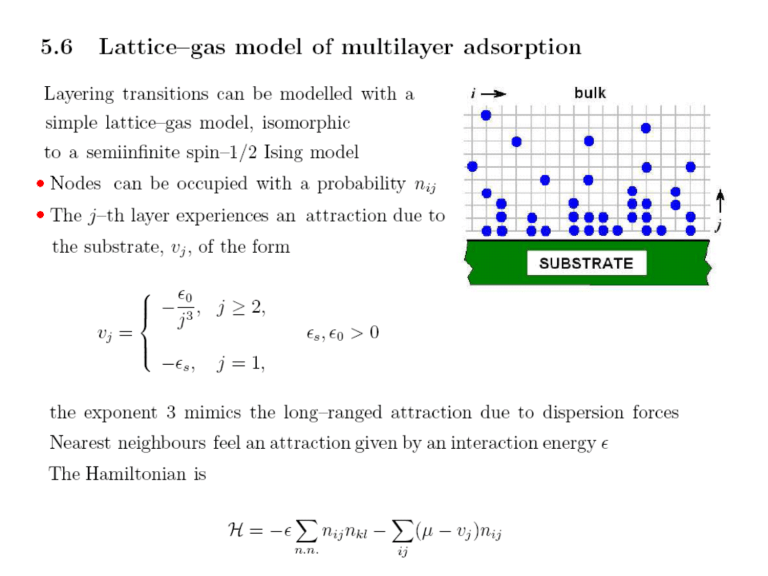
ADSORPTION ISOTHERMS discontinuous jumps: layering transitions bilayer condensation monolayer condensation coexistence pressure some layering transitions
t
= 0.45
0.60
two-phase region two-phase region two-phase region two-phase region two-phase region liquid-vapour transition of monolayer
at two-phase coexistence
SV
SL
LV
SV
SL
=
LV q > 0 q = 0
Y ( r s
)
Y ( r s
) = Q ( r s
)
if there exists e such that there is a wetting transition, this is of 2 nd order r s
Y ( r s
)
PARTIAL
WETTING
T<T
W
PARTIAL
WETTING
T<T
W
COMPLETE
WETTING
T=T
W
COMPLETE
WETTING
T>T
W
r
V r s d r
Y ( r
)
= r
V r s d r
r e
=
2
r s
2 r
V
2
r s
r
V
=
0
( r s
)
0
( r
V
) area under curve
contribution from hard interaction contribution from attractive interaction
(with correlations = step function)
a
0, b
| a
|, l
< l s a
0, b
>0, l s
< l a(T
W
)
=0
Adsorption isotherms: Langmuir's model
Kr adsorbed on exfoliated graphite at T=77.3K
N s adatoms
e s binding energy
N adsorption sites ( N > N s
)
Distinguishable, non-interacting particles
Vapour sector
The partition function is:
Z
N
= i e
E i
=
N s
!
(
N !
N
N s
)!
e
N e s
Using Stirling's approx., the free energy is:
F
= kT log Z
N
=
N e s
N s kT
q log q q =
N s
/ N coverage
( 1
q
) log( 1
q
)
Chemical potential of the film:
f
=
F
N
N s
, T
=
F
q d q
N s
, T dN
= e s
kT log q
1
q
Film and bulk vapour are in equilibrium:
e s
kT log q
1
q
= kT log
kT p
3
p
* p
3 kT
= q e
e s
1
q
At low coverage p
* = q e
e s
1
q
...
q e
e s linear for low q
(Henry's law)
This allows for an estimation of adsorption energies e s measuring the p q slope by
Fowler and Guggenheim's model
Langmuir considers no mobility
Fowler and Guggenheim neglect xy localisation, consider full mobility (localisation only in z) and again no adatom interaction
E s
H
=
N e s
i
N
=
1
The free energy is: p i
2
2 m
F
=
N
e s
kT log
Ae
N
2
Z
N
=
1
N !
Ae
e s
2
N
Linear regime: has to do
A = surface area with absence of interactions
Again, calculating to
f and equating
of the (ideal) bulk gas: p
* = 2 ne
e s n
=
N / A
q
(two-dimensional density)
Binder and Landau
Monte Carlo simulation of lattice-gas model with parameters for adsorption of H on Pd(100)
Limiting isotherm for T
=
Corrections from 2D virial coefficients
two-phase regions
2D critical points
Multilayer condensation in the liquid regime ellipsometric adsorption measurements of pentane on graphite
Kruchten et al. (2005)
Full phase diagram of a monolayer
Periodic quasi-2D solid
Commensurate or incommensurate?
Ar/graphite (Migone et al. (1984) incommensurate solid
Kr/graphite two length scales:
• lattice parameter of graphite
• adatom diameter three energy scales :
• adsorption energy
• adatom interaction
• kT (entropy) commensurate monolayer
3
3
30 º incommensurate monolayer
(also called floating phase)
Specht et al. (1984)
Kr/graphite
Two-dimensional crystals
Absence of long-range order in 2D (Peierls, '30)
There is no true long-range order in 2D at T>0 due to excitation of long wave-length phonons with
kT n k
, s
=
( k
, s ) kT
k
, s population of phonons with frequency mode with force constant f k
, s
= m
k , s
k , s
1
2 f k
, s x k
2
, s
= n k , s
k
, s
= kT
k
, s
k
, s
The total mean displacement is
= kT x
2 = kT m
2
1
, s
a
1 d x k
L
1
= g (
)
2
2 kT m
2
k , s
Using the Debye approximation for the density of states: g (
)
2
,
, 3 D
2 D
The mean square displacement when L goes to infinity is x
2 = kT m
1
2 d
g (
)
2
a
1
L
1
L log a
const
, 3 D
2 D
Therefore, the periodic crystal structure vanishes in the thermodynamic limit
However, the divergence in < x 2 > is weak: in order to have x
2 a
2 , L has to be astronomical!
This is for the harmonic solid; there are more general proofs though
XY model and Kosterlitz-Thouless (KT)
Freely-rotating 2D spins
J
s i
s
j
=
J cos
i
j
The ground state is a perfectly ordered arrangement of spins
But: there is no ordered state (long-range order) for T>0
Consider a spin-wave excitation:
The energy is:
L ( 2
/ L ) in 1 D
L
2
( 2
/ L ) in 2 D
L
3
( 2
/ L ) in 3 D goes to a constant: spin wave stable and no ordered state limiting case (in fact NO) grows without limit: ordered state robust w.r.t. T
Even though there is no long-range order, there may exist quasi-longrange order
No true long-range order: exponentially decaying correlations
• True long-range order: correlation function goes to a constant
• Quasi-long-range order(QLRO): algebraically decaying correlations
QLRO corresponds to a critical phase
Not all 2D models have QLRO:
• 2D Ising model has true long-range order (order parameter n=1 )
• XY model superfluid films, thin superconductors, 2D crystals (order parameter n=2 ) only have QLRO
Spin excitations in the XY model can be discussed in terms of vortices (elementary excitations), which destroy long-range order
vortex topological charge = +1 antivortex topological charge = -1
We calculate the free energy of a vortex
The contribution from a ring a spins situated a distance r from the vortex centre is
q =
2
2
r
=
1
, r
J
2
q
2
=
J r
The total energy is
E v
=
L a dr
J r
=
J log
L a
The free energy is
F v
=
E v
TS v
=
J log
L
kT log a lattice parameter
L a
2
=
J
2 kT
log
L a the vortex centre can be located at ( L/a ) 2 different sites
When F v
= 0 vortex will proliferate:
Vortices interact as
=
Kv i v j log r ij a kT c
J
=
2
=
1 .
571 ...
Vortices of same vorticity attract each other
Vortices of different vorticity repel each other
But one has to also consider bound vortex pairs
-1 +1
They do not disrupt order at long distances
Easy to excite
Screen vortex interactions
KT theory: renormalisation-group treatment of screening effects
Confirmed experimentally for 2D supefluids and superconductor films. Also for XY model (by computer simulation)
Predictions:
• For T>T c there is a disordered phase, with free vortices and free bound vortex pairs s
i
s
j
e
r ij
/
for T
T c
• For
T<T c
s i
• For
T=T c there is QLRO (bound vortex pairs)
s
j
r
( T )
1
4 for T there is a continuous phase transition
T c
K renormalises to a universal limiting value and then drops to zero
Two-dimensional melting
The KT theory can be generalised for solids: KTHNY theory
There is a substrate. Also, there are two types of order:
• Positional order : correlations between atomic positions
Characterised e.g. by g
r
r
'
• Bond-orientational order : correlations between directions of relative vectors between neighbouring atoms w.r.t. fixed crystallographic axis: g
6
r
r
'
= e
6 i
q
( r
)
q
( r
' )
The analogue of a vortex is a a disclination
A disclination disrupts long-range positional order, but not the bond-orientational order
In a crystal disclinations are bound in pairs, which are dislocations, and which restore (quasi-) long-range positional order
Dislocations
Burgers vector


